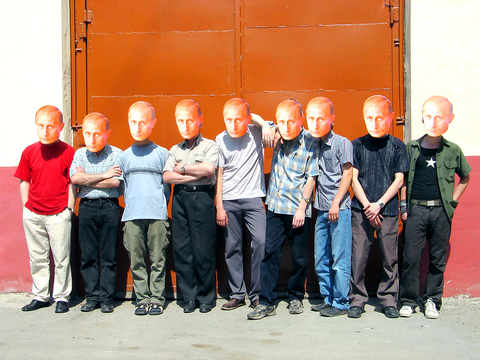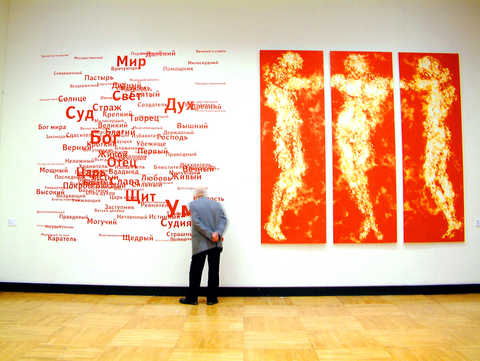After last year's terrorist attack on a school in Beslan, Russia, and President Vladimir Putin's subsequent steps to strengthen his political power, Marat Guelman formulated a response of sorts. It was an artistic doctrine and a political declaration, a social and cultural challenge to the state of what he called Russia 1.
Guelman, owner of one of the country's first post-Soviet art galleries, called his project Russia 2 and opened it with an exhibition of paintings and other works intended to parallel Moscow's first biennial of contemporary art last January and February. The exhibition's tone was irreverent, subversive and piercingly critical of Putin, the Kremlin and, significantly, the Russian Orthodox Church.
Not surprisingly, perhaps, Russia 1 has struck back.

PHOTO: NY TIMES NEWS SERVICE
A group of nine artists unaffiliated with the exhibit has filed a civil suit against Guelman and the exhibition hall where the works first appeared, the Central House of Artists. They are see-king the equivalent of US$175,000 in compensation for the "moral injury" caused by four of the works, by some of Russia's most prominent contemporary artists: Gor Chahal; Marina Kolodobskaya; the comic pair Vyacheslav Mizin and Aleksandr Shaburov, known as the Blue Noses; and the trio of conceptual artists calling themselves A.E.S.
"The openly confrontational, provo-cative and scandalous nature of the exhibition does not fit in any account to any understanding of art and has nothing in common with it," the artists' complaint reads. A court in Moscow began hearing the case this month, and its next session is scheduled for Monday (Dec. 5).
Next Thursday, a large selection of Russia 2 is to go on view in New York City at the White Box gallery in Chelsea. Other works from the Moscow show are to appear at Magnan Projects' Annex in Chelsea and at Ethan Cohen Fine Arts in TriBeCa from Dec. 8 to Jan. 11.

PHOTO: NY TIMES NEWS SERVICE
The complaint filed in Moscow cited provisions in Russia's Constitution protecting human rights and religious freedom and an article in the criminal code against inciting ethnic and religious hatred. That article was the basis earlier this year for the criminal conviction of the director and a curator at the Andrei Sakharov Museum in Moscow on a charge arising from a 2003 exhibition of paintings and sculptures that many saw as ridiculing the Russian Orthodox Church. The director, Yuri Samodurov, and the curator, Lyudmila Vasilovskaya, were fined US$3,600 each, although not imprisoned as prosecutors had demanded.
Like the Sakharov case, the dispute over Russia 2 has thrust into opposition two groups -- artists and the religiously observant -- that suffered enormously under state-imposed ideology in the Soviet Union but have flourished since the state unraveled in 1991. It also underlines what Putin's critics argue is the emergence of a new ideology, with the church at its foundation, that rarely tolerates public criticism of the state and its symbols.
Which was Guelman's point in the first place.
"It is not at all like it was in Soviet times, when art was underground," he said in an interview in his loftlike apartment, which looks out on the newly rebuilt Christ the Savior Cathedral. "It is just that there are two countries that exist today in Russia. Russia 2 showed this."
The exhibition drew complaints from the start. A group of nationalists in the Russian Parliament quickly appealed to prosecutors, as did members of the church. It was a group of artists, though, who filed formal charges, in both criminal and civil court. They are all members of the Moscow Union of Artists -- a sort of official academy -- who are Orthodox believers.
One of them, Dmitri Shmarin, a neo-realist painter, said in an interview that he saw no contradiction in artists suing other artists over the content of their work.
"We are not trying to restrict artistic freedom," he said. "Artists, of course, can do whatever they want, but if they insult us, we ask the state to protect us."
He called the works in Russia 2 blasphemous, adding that they were intended to "destabilize the internal peace of our country."
Chahal's triptych, The Sun of Truth, Kindness and Beauty, depicted nearly abstract figures that appeared, crucified, in flames. Kolodobskaya created an iconlike sculpture into which viewers can peek to watch a video, some of it sexually explicit.
A.E.S. -- named for the initials of its artists, Tatiana Arzamasova, Lev Evzovich and Evgeny Svyatsky -- displayed several photographic compositions from its long-running Islamic Project series, which merge images of the Muslim world with landmarks like the Statue of Liberty. The complaint specifically cites Moscow 2006, which depicts a futuristic Kremlin with minarets and other architectural features from the Muslim world.
The artists known as the Blue Noses -- - with "sarcasm and irony," according to the complaint -- contributed a photographic composition showing Pushkin, Putin and an icon of Jesus Christ transposed on a man's naked torso.
A criminal investigation began, but in the spring, prosecutors declined to press charges. The civil case was dismissed on a technicality but was later revived. In addition to the US$175,000 in damages, the complaint asks the courts to prohibit any future display of the works in Russia, from galleries to magazines or other printed media.

June 9 to June 15 A photo of two men riding trendy high-wheel Penny-Farthing bicycles past a Qing Dynasty gate aptly captures the essence of Taipei in 1897 — a newly colonized city on the cusp of great change. The Japanese began making significant modifications to the cityscape in 1899, tearing down Qing-era structures, widening boulevards and installing Western-style infrastructure and buildings. The photographer, Minosuke Imamura, only spent a year in Taiwan as a cartographer for the governor-general’s office, but he left behind a treasure trove of 130 images showing life at the onset of Japanese rule, spanning July 1897 to

One of the most important gripes that Taiwanese have about the Democratic Progressive Party (DPP) is that it has failed to deliver concretely on higher wages, housing prices and other bread-and-butter issues. The parallel complaint is that the DPP cares only about glamor issues, such as removing markers of Chinese Nationalist Party (KMT) colonialism by renaming them, or what the KMT codes as “de-Sinification.” Once again, as a critical election looms, the DPP is presenting evidence for that charge. The KMT was quick to jump on the recent proposal of the Ministry of the Interior (MOI) to rename roads that symbolize

On the evening of June 1, Control Yuan Secretary-General Lee Chun-yi (李俊俋) apologized and resigned in disgrace. His crime was instructing his driver to use a Control Yuan vehicle to transport his dog to a pet grooming salon. The Control Yuan is the government branch that investigates, audits and impeaches government officials for, among other things, misuse of government funds, so his misuse of a government vehicle was highly inappropriate. If this story were told to anyone living in the golden era of swaggering gangsters, flashy nouveau riche businessmen, and corrupt “black gold” politics of the 1980s and 1990s, they would have laughed.

In an interview posted online by United Daily News (UDN) on May 26, current Chinese Nationalist Party (KMT) Chairman Eric Chu (朱立倫) was asked about Taichung Mayor Lu Shiow-yen (盧秀燕) replacing him as party chair. Though not yet officially running, by the customs of Taiwan politics, Lu has been signalling she is both running for party chair and to be the party’s 2028 presidential candidate. She told an international media outlet that she was considering a run. She also gave a speech in Keelung on national priorities and foreign affairs. For details, see the May 23 edition of this column,